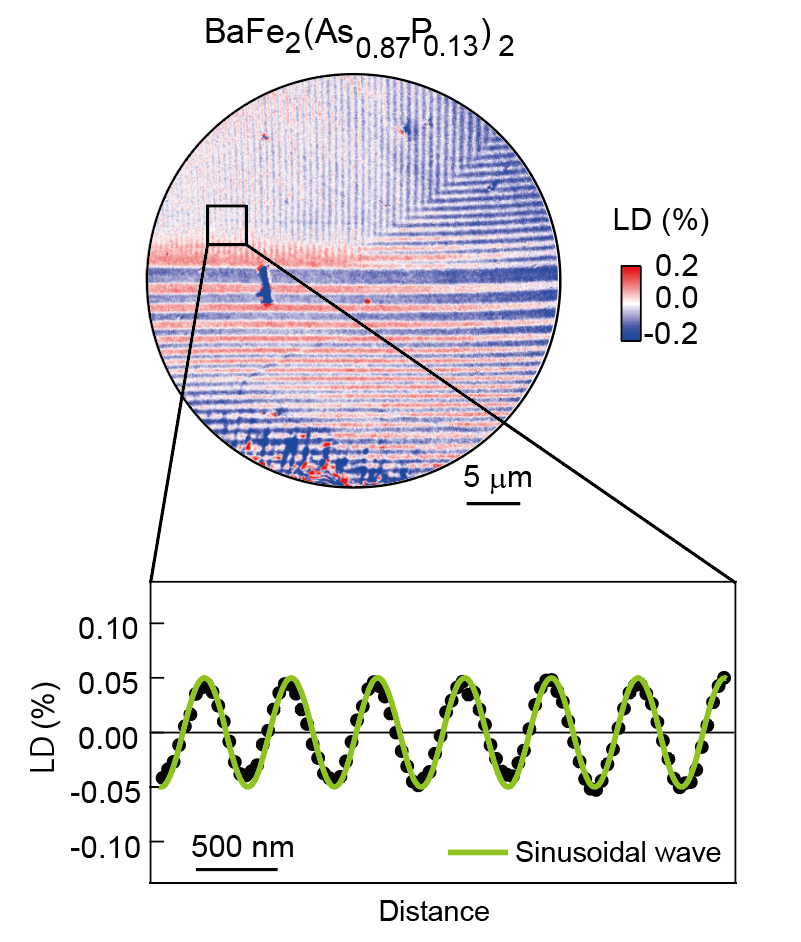Reviewed by Alex SmithSep 3 2021
Researchers at the University of Tokyo observed a strange signal relating to the way electrons are organized. This was observed while analyzing the behavior of iron-based superconducting materials.
 Nematicity wave. An image captured by laser-PEEM showing the arrangement of electrons in a sample of IBSC material. In this technique, images are made from laser light illuminating the sample in two different directions. Linear dichroism (LD) refers to the difference between the images made from these two illumination directions; it allows you to see details you could not see otherwise, such as in this case the distribution of electrons. Image Credit: Shik Shin et al.
Nematicity wave. An image captured by laser-PEEM showing the arrangement of electrons in a sample of IBSC material. In this technique, images are made from laser light illuminating the sample in two different directions. Linear dichroism (LD) refers to the difference between the images made from these two illumination directions; it allows you to see details you could not see otherwise, such as in this case the distribution of electrons. Image Credit: Shik Shin et al.
The signal refers to a new arrangement of electrons, which are called a nematicity wave, and the researchers are looking to join hands with theoretical physicists to better understand the details. The nematicity wave can enable researchers to gain insights into the process by which electrons interact with each other in superconductors.
A long-term objective of solid-state physicists is to completely understand the superconductivity phenomena — mainly, electronic conduction without the resistance that produces heat and drains power.
It would lead to a completely new world of highly efficient, powerful devices. It is already being used in Japan for the experimental magnetic levitation bullet train. However, there is more to understand regarding this, and it generally surprises researchers with unexpected results and observations.
Professor Shik Shin from the Institute for Solid State Physics at the University of Tokyo and his colleagues are studying the electron behavior in iron-based superconducting materials (IBSCs). These materials express many promising factors as they are capable of working at high temperatures than other superconducting materials. This is a key matter of concern.
Moreover, they use less exotic material components to ensure simplicity and cost-efficiency. To activate the superconducting ability of a sample, the material must be cooled down to several hundreds of degrees below zero. Many exciting scenarios happen during the cooling process.
As IBSCs cool down to a certain level, they express a state we call electronic nematicity. This is where the crystal lattice of the material and the electrons within it appear to be arranged differently depending on the angle you look at them, otherwise known as anisotropy. We expect the way electrons are arranged to be tightly coupled to the way the surrounding crystal lattice is arranged. But our recent observation shows something very different and actually quite surprising.
Shik Shin, Professor, Institute for Solid State Physics, University of Tokyo
The researchers employed a special approach designed by their laser-PEEM (photoemission electron microscopy) group to observe their IBSC sample on the microscopic scale. The researchers expected to observe a well-known pattern that repeats every few nanometers. The crystal lattice also expressed this pattern. However, surprisingly, they observed a repeating pattern of electrons every few hundred nanometers.
The differences between the electron nematicity wave and the crystalline structure of the IBSC were unpredicted, meaning that its implications are still under the research phase. The outcomes could lead to theoretical and experimental explorations into something basic to the phenomenon of superconductivity. This is a method by which the electrons form pairs at low temperatures.
Understanding this process could be critical to developing high-temperature superconductivity. Thus, it is important to understand the role of nematicity waves.
Next, I hope we can work with theoretical physicists to further our understanding of nematicity waves. We also wish to use laser-PEEM to study other related materials such as metal oxides like copper oxide. It may not always be obvious where the applications lie, but working on problems of fundamental physics really fascinates me.
Shik Shin, Professor, Institute for Solid State Physics, University of Tokyo.
Journal Reference:
Shimojima, T., et al. (2021) Discovery of mesoscopic nematicity wave in iron-based superconductors. Science. doi.org/10.1126/science.abd6701.